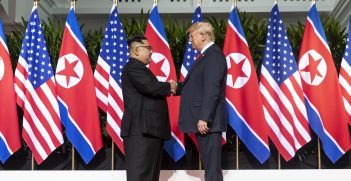Australia's New Consular Diplomacy

Globalising forces have stimulated a rapid expansion in overseas travel by Australians. As a result, Australia’s diplomats have struggled with a burgeoning consular workload. This has led to pressures on the consular service, ranging from changing demographics, travel habits and destinations to the persistent problem of the unrealistic expectations travellers have of the consular assistance that government can provide.
Consular cases are becoming increasingly complex: Australia’s multiculturalism is manifested in more dual and multiple citizenships, and globalisation has created a significant expatriate population and a public which travels very widely. Media attention has spurred political intervention in some high-profile consular cases, contributing further to the already high expectations of travellers who encounter difficulty abroad. Finally, Australia’s stretched diplomatic service is pressed to fulfil its charter, particularly at times of crisis, when consular demands draw resources from the other work of the Department of Foreign Affairs and Trade (DFAT).
These pressures are not unique to Australia. Many governments, both of developed and developing nations, report similar challenges. As a result, many have elevated consular assistance in importance, where once it was regarded as the ‘Cinderella’ of the foreign service. Some have conducted inquiries into their consular services and formulated new strategies for dealing with the changing conditions. The Australian government is one of them.
Consular strategy
There have been promising signs over the last two years that both the government and DFAT are moving to address some of the challenges discussed above, in particular in the area of communications, in political messaging and in addressing the ‘diplomatic deficit’.
In formulating the new Consular Strategy 2014–16, the government consulted widely. The resulting strategy reflects not just the consultation, but also the learnings of the last decades of DFAT’s consular operations. The primary thrusts of the strategy are threefold: to clarify and modify what DFAT will do in assisting citizens; to exhort them to take more responsibility for their actions overseas; and to direct resources to those in greatest need. In an operational sense, the strategy heralds better use of new media and technological advances, and signals more international cooperation in order to expand DFAT’s reach.
Assistance as privilege
On the first thrust, the consular strategy and the minister for foreign affairs made clear there is no move to enshrine a ‘right’ to consular assistance in law. Contrary to some popular misconceptions, there is no entitlement to consular protection in Australian law. While some states do enshrine the right to protection in law—by their constitution (such as Bulgaria, Croatia, Estonia and Poland) or in domestic laws (such as in Denmark, Finland, Portugal, Sweden and Germany)—Australia is not among them. Julie Bishop, Minister for Foreign Affairs, has sent a “very clear message [to Australians]: consular assistance should not be seen as a right, it is a privilege”.
The strategy breaks new ground, indicating that consular assistance may even be limited in cases of deliberate illegal behaviour or repeated acts of recklessness or negligence. A new and simplified Consular Services Charter emphasises the need for adequate travel insurance, although more could be done to stimulate uptake of insurance amongst the travelling public, only 50–62 per cent of whom had insurance in 2012.
Stretched resources
The new posts announced in the 2015–16 and 2016–17 federal budgets are a welcome start in addressing the overstretched diplomatic network. However, more is needed. Australia’s network of overseas missions falls well short of its needs. Even leaving aside the forces of globalisation, an island nation requires strong international engagement and an adequate diplomatic and consular presence.
On most other measures, Australia ranks very strongly: it has the 12th largest economy in terms of gross domestic product, the 12th largest defence expenditure, and the 14th largest aid budget. Yet its diplomatic network is smaller than that of all the Group of Twenty nations, except Saudi Arabia, in terms of the number of posts. Even if and when all the new posts are opened, Australia’s network will rank at around 18th or 19th in the OECD in size, behind Belgium and Portugal.
The ‘integrated’ DFAT has suffered huge staff cuts (with around 600–650 positions cut in the past three years). Compounding that pressure, the opening of new missions will divert staff from other missions or roles, without further resourcing. It is hard to see how DFAT can properly staff its expanded network in the absence of a new funding boost.
Aside from pressures on overall resourcing of the department, data on DFAT’s funding of the consular function suggests that the resourcing for consular services is not growing commensurately with demand. Most of the resourcing is directed to the provision of passports. Further, the rising complexity of the consular workload described earlier warrants a close examination of the composition and fitness of the consular workforce to meet those demands. Forced marriages, child abductions, custody disputes and mental illness cases are complex situations requiring specific skills and specialised training. Cases such as the Faulkner children’s abduction show that DFAT might benefit from dedicated in-house specialist capability, such as that of Global Affairs Canada.
Right response
Over the past few decades, the consular role has expanded and become increasingly complex. It is unlikely that the conditions that have spurred the growth in international travel and generated the higher expectations of government consular assistance will dissipate. The government’s thrust towards self-reliance, and its limiting of circumstances in which assistance will automatically be given, is the right response, and its increasing confidence in communicating through new media tools is encouraging.
Its initial moves to expand its diplomatic network with new posts and cooperation with like-minded nations are a positive step. The minister for foreign affairs’ approach to individual cases and dealings with the media has been, for the most part, firm and balanced. But the problems facing the consular service are far from solved.
DFAT needs to be vigilant in monitoring caseloads geographically, reviewing trends in travel across demographic groups, enabling more effective communication and continuing the push towards greater self-reliance. It should examine its resourcing of the consular function and the capability of the consular cadre to meet the demands of the increasingly complex workload.
Government needs to back up its initial reinvestment in the diplomatic network with better resourcing to expand Australia’s presence internationally and boost its capabilities at important locations. Only then can it and DFAT achieve a workable balance between promoting and safeguarding the national interest while providing the necessary protection for Australian citizens abroad.
Alex Oliver is the director of the Polling Program at the Lowy Institute. She is responsible for the Lowy Institute’s program on public opinion and foreign policy, including the annual Lowy Institute Poll and polling projects overseas.
This article is an extract from Oliver’s article in Volume 70, Issue 6 of the Australian Journal of International Affairs titled ‘Travelling responsibly, but further to go: Australia’s new consular diplomacy’. It is republished with permission.





